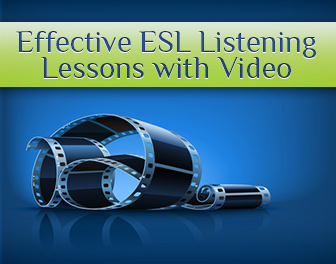Out of all of the listening material you can give your ESL students, videos are the most enjoyable, as they have images that help students grasp meaning.
But if the video is too hard, your ESL learners will tune out. If it’s too easy, they will sit back, relax and simply enjoy the show. If you want to show your students videos that will effectively boost their listening, you’ll need to consider a few things.

Effective Video Lessons: 7 Keys to Success
-
1
Authentic or Made for ESL Students?
The first thing you’ll need to consider is whether you’ll show your class a video that was especially made for English teaching or authentic video, like movies, cartoons or TV shows. Each has its own set of advantages and disadvantages:
- Authentic material is usually far more interesting to students and also much more realistic. Actors speak at a normal pace, and this can be good or bad depending on your students’ level. The video may be too hard to understand, but perfect for advanced students who need a challenge. The one obvious disadvantage is that this material does not come with worksheets or activity books. You have to design your own or get them elsewhere (lucky for you, there are plenty available at BusyTeacher.org!)
- Video made for ESL students comes ready to teach, with activities and exercises. It’s also made to suit a particular level, with scenes that target a specific set of vocabulary or grammar, so there’s no guesswork there. The main disadvantage is that this material often fails to engage learners – the acting is exaggerated and the situations seem contrived.
My general recommendation is to use ESL videos for beginners and authentic material for more advanced learners, but try to show beginners authentic video once in a while, even if it’s a short weather report or movie trailer.
-
2
With or Without Sound? Or Picture?
Any teacher who has shown a video to a class knows that it’s not as simple as popping in the CD and pressing play. At least, effective video lessons shouldn’t be this way. They need a little work. There are several ways in which you can show a video to maximize listening:
- Play video without sound, first. Then play it with sound. This way they can get the gist of what the action will be, what feelings will be aroused and be ready to listen to what will be said.
- Play video without picture, first. Students will be forced to really listen to figure out what’s going on. Will they get it right? Play the video a second time with audio and picture to confirm.
-
3
With or Without Subtitles?
This is another thing that may depend on your students’ level. As a rule of thumb, more advanced students should not have the subtitles on. But this may depend on the video (authentic or made for ESL) and each particular group. In any case, if students watch a video with subtitles, they should be in English, and you should at some point be able to turn them off.
-
4
Complete or Paused?
Will you show the complete video through to the end, or pause in the middle to check for comprehension or do an activity? This again, depends on the group, but more so on the length of the video. Movies should definitely be paused at some strategic points, in fact, they may be watched over the course of several days. If you’re also teaching a grammar point or reviewing vocabulary, you might want to pause the video to review these concepts. Unless the video is very short (less than 5 minutes), I like to divide it into parts.
-
5
Length? Content? Quality?
This may seem like an obvious step, but teachers often make the mistake of trusting the CD or video file, and not checking it before class. This is especially important if you’ll be using authentic video and not the kind prepared specifically for ESL students. Be especially careful with YouTube videos. How long is the video? Is there anything about the content that may not be appropriate for children? Is it good quality video or does it end abruptly for no apparent reason?
-
6
Do You Have Everything You Need?
Leave it Murphy’s Law. Anything that could go wrong will go wrong in your video lesson. Do you have all of the necessary accessories/power cords for the computer or DVD player? Are there batteries in the remote? Is your laptop battery fully charged? You may think these are minor details, but believe me, you don’t want to loose precious minutes of your lesson or worst of all have students staring at the ceiling while you sort out your technical problems. If possible, arrive early to set everything up and make sure everything is working properly.
-
7
What Will They Do during the Video?
What type of worksheet will you give them? What will be the task? Listening for gist? Or answering comprehension questions? If you decide to use authentic video, you’ll have to create one yourself.
Never underestimate a video’s ability to help improve listening – and entertain in the process. It’s a treat that students of any level will welcome!
What is your experience with video lessons?
Share below!
P.S. If you enjoyed this article, please help spread it by clicking one of those sharing buttons below. And if you are interested in more, you should follow our Facebook page where we share more about creative, non-boring ways to teach English.







